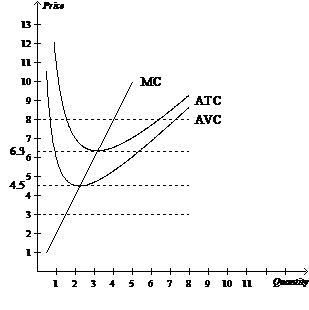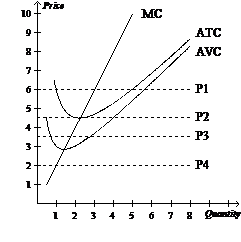College of Saint Benedict Profit Maximizing Firms and Competitive Market Questions
Description

Having Trouble Meeting Your Deadline?
Get your assignment on College of Saint Benedict Profit Maximizing Firms and Competitive Market Questions completed on time. avoid delay and – ORDER NOW
Question 1 (5 points)
Profit-maximizing firms enter a competitive market when existing firms in that market have
Question 2 (5 points)
Table 14-9
Suppose that a firm in a competitive market faces the following revenues and costs:
|
Quantity |
Total Revenue |
Total Cost |
|
0 |
$0 |
$10 |
|
1 |
$9 |
$14 |
|
2 |
$18 |
$19 |
|
3 |
$27 |
$25 |
|
4 |
$36 |
$32 |
|
5 |
$45 |
$40 |
|
6 |
$54 |
$49 |
|
7 |
$63 |
$59 |
|
8 |
$72 |
$70 |
|
9 |
$81 |
$82 |
Refer to Table 14-9. If the firms marginal cost is $11, it should
Question 3 (5 points)
Which of the following statements best reflects a price-taking firm?
Question 4 (5 points)
A firm that has little ability to influence market prices operates in a
Question 5 (5 points)
Table 14-9
Suppose that a firm in a competitive market faces the following revenues and costs:
|
Quantity |
Total Revenue |
Total Cost |
|
0 |
$0 |
$10 |
|
1 |
$9 |
$14 |
|
2 |
$18 |
$19 |
|
3 |
$27 |
$25 |
|
4 |
$36 |
$32 |
|
5 |
$45 |
$40 |
|
6 |
$54 |
$49 |
|
7 |
$63 |
$59 |
|
8 |
$72 |
$70 |
|
9 |
$81 |
$82 |
Refer to Table 14-9. In order to maximize profit, the firm will produce a level of output where marginal reve-nue is equal to
Question 6 (5 points)
Table 14-4
|
Quantity |
Total Revenue |
|
0 |
$0 |
|
1 |
$15 |
|
2 |
$30 |
|
3 |
$45 |
|
4 |
$60 |
Refer to Table 14-4. For a firm operating in a competitive market, the average revenue is
Question 7 (5 points)
For a firm in a competitive market, an increase in the quantity produced by the firm will result in
Question 8 (5 points)
Comparing marginal revenue to marginal cost
(i) reveals the contribution of the last unit of production to total profit.
(ii) is helpful in making profit-maximizing production decisions.
(iii) tells a firm whether its fixed costs are too high.
Question 9 (5 points)
Table 14-9
Suppose that a firm in a competitive market faces the following revenues and costs:
|
Quantity |
Total Revenue |
Total Cost |
|
0 |
$0 |
$10 |
|
1 |
$9 |
$14 |
|
2 |
$18 |
$19 |
|
3 |
$27 |
$25 |
|
4 |
$36 |
$32 |
|
5 |
$45 |
$40 |
|
6 |
$54 |
$49 |
|
7 |
$63 |
$59 |
|
8 |
$72 |
$70 |
|
9 |
$81 |
$82 |
Refer to Table 14-9 At which quantity of output is marginal revenue equal to marginal cost?
Question 10 (5 points)

Figure 14-1
Suppose that a firm in a competitive market has the following cost curves:
Refer to Figure 14-1. The firm should shut down if the market price is
Question 11 (5 points)
Cold Duck Airlines flies between Tacoma and Portland. The company leases planes on a year-long contract at a cost that averages $600 per flight. Other costs (fuel, flight attendants, etc.) amount to $550 per flight. Currently, Cold Duck’s revenues are $1,000 per flight. All prices and costs are expected to continue at their present levels. If it wants to maximize profit, Cold Duck Airlines should
Question 12 (5 points)

Figure 14-1
Suppose that a firm in a competitive market has the following cost curves:
Refer to Figure 14-1. The firms short-run supply curve is its marginal cost curve above
Question 13 (5 points)
If a competitive firm is currently producing a level of output at which marginal revenue exceeds marginal cost, then
Question 14 (5 points)
Table 14-13
Dianas Dress Emporium
|
COSTS |
REVENUES |
|||||
|
Quantity Produced |
Total Cost |
Marginal Cost |
Quantity Demanded |
Price |
Total Revenue |
Marginal Revenue |
|
0 |
$100 |
— |
0 |
$120 |
— |
|
|
1 |
$150 |
1 |
$120 |
|||
|
2 |
$202 |
2 |
$120 |
|||
|
3 |
$257 |
3 |
$120 |
|||
|
4 |
$317 |
4 |
$120 |
|||
|
5 |
$385 |
5 |
$120 |
|||
|
6 |
$465 |
6 |
$120 |
|||
|
7 |
$562 |
7 |
$120 |
|||
|
8 |
$682 |
8 |
$120 |
|||
Refer to Table 14-13. What is the marginal cost of the 1st unit?
Question 15 (5 points)

Figure 14-2
Suppose a firm operating in a competitive market has the following cost curves:
Refer to Figure 14-2. Which of the four prices corresponds to a firm earning negative economic profits in the short run but trying to remain open?
Question 16 (5 points)
Scenario 14-3
Suppose a certain competitive firm is producing Q=500 units of output. The marginal cost of the 500th unit is $17, and the average total cost of producing 500 units is $12. The firm sells its output for $20.
Refer to Scenario 14-3. At Q=499, the firms total costs equal
Question 17 (5 points)
When a restaurant stays open for lunch service even though few customers patronize the restaurant for lunch, which of the following principles is (are) best demonstrated?
(i) Fixed costs are sunk in the short run.
(ii) In the short run, only fixed costs are important to the decision to stay open for lunch.
(iii) If revenue exceeds variable cost, the restaurant owner is making a smart decision to remain open for lunch.
Question 18 (5 points)
Suppose that a firm in a competitive market is currently maximizing its short-run profit at an output of 50 units. If the current price is $9, the marginal cost of the 50th unit is $9, and the average total cost of producing 50 units is $4, what is the firm’s profit?
Question 19 (5 points)
Suppose a firm in each of the two markets listed below were to increase its price by 30 percent. In which pair would the firm in the first market listed experience a dramatic decline in sales, but the firm in the second mar-ket listed would not?
Question 20 (5 points)

Figure 14-1
Suppose that a firm in a competitive market has the following cost curves:
Refer to Figure 14-1. If the market price falls below $4.50, the firm will earn
Question 21 (5 points)
Table 14-10
Suppose that a firm in a competitive market faces the following revenues and costs:
|
Quantity |
Total Revenue |
Total Cost |
|
0 |
$0 |
$3 |
|
1 |
$7 |
$5 |
|
2 |
$14 |
$9 |
|
3 |
$21 |
$15 |
|
4 |
$28 |
$23 |
|
5 |
$35 |
$33 |
|
6 |
$42 |
$45 |
|
7 |
$49 |
$59 |
Refer to Table 14-10. Which level of production in the table has the lowest average variable cost?
Question 22 (5 points)
If a firm in a perfectly competitive market triples the quantity of output sold, then total revenue will
Question 23 (5 points)
Which of the following statements best expresses a firms profit-maximizing decision rule?
Question 24 (5 points)
When firms are said to be price takers, it implies that if

